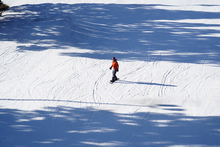Snowmaking - It's Winter Every Day At Mountain High
Snowmaking is essential in order to ski Southern California's Resorts and your local areas have some of the largest snowmaking systems in the world. Using water and air, the same two elements as Mother Nature, we make snow all season long to provide you with the best possible conditions. This is why Mountain High is traditionally the first resort to open in Southern California and the last to close.
"We'll work around the clock if the weather is right," says their Snowmaking Manager. "With good conditions, we can make enough snow to cover a one mile stretch of the 405 freeway with a foot of new snow overnight."
Here's an important fundamental: SNOW MADE AT THE RESORTS IS REAL SNOW. There's nothing artificial about it. Snow crystals, however they are produced, are simply minute crystals of frozen water.
In nature, the evaporation of water creates moisture in the atmosphere. This moisture condenses and when the weight of the moisture exceeds the capacity of the air to keep it aloft, it falls to the ground. If the air above the ground is cold enough, water falls as snow. Often the crystals pick up more moisture as they fall, resulting in the myriad shapes for which snow crystals are famous.
Snowmaking shortcuts Nature's process. There's no evaporation phase. Rather, water is forced through a specialized nozzle or "gun" where it collides with highly pressurized air. The compressed air shatters the stream of water into minute particles and launches them into the atmosphere where they freeze and fall to the ground.
To ski Southern California, snowmakers take two factors have a profound influence on the process; temperature and relative humidity. People often look at their free thermometers on their ski jackets and say, "Hey, it's 32 degrees, why aren't they making snow?" The answer is humidity. In general, the more humid the air, the lower the temperature has to be to be to make snow. As a result, modern snowmakers are more interested in the "wet bulb" temperature, which is a combination of dry bulb temperature and relative humidity. When the air is saturated and cannot hold any more moisture, the dry bulb and wet bulb temperatures are exactly the same (this is also known as the dew point). But when humidity is extremely low, the wet bulb temperature may actually be subfreezing (less than 32 degrees Fahrenheit) when the dry bulb temperature is as high as 40 degrees. This makes it possible to make snow at temperatures well above "freezing."
Another comment often heard in the lift lines is, "Why is the snow so heavy?"
Light, dry snow is certainly the most fun to ride. But it isn't always optimal depending on what the resort is trying to do. At areas with sophisticated snowmaking control systems, crews will sometimes make wet snow deliberately because they can cover the trails quicker and it provides a better base. This is generally done when a trail is first opened for the season, or when a thaw cycle has reduced base depth.
There are two basic weapons in the snowmaker's arsenal; guns which work with compressed air and airless guns. Compressed air guns utilize compressed air to propel water droplets into the atmosphere where they crystallize and fall to the ground as snow. These air/water guns actually work better in warmer temperatures which is why they are favored by local resorts but they require a lot of infrastructure to support them: two sets of pipes running up the mountain (one for air and one for water), and a pumping and compressing facility at the base of the mountain. The other major type of snow making gun is the airless gun. These contraptions look like oil barrels with fans at the back of them. Airless guns spray water out of small nozzles similar to the spray valves on garden hoses. The nozzles ring a large, electrically powered fan in the center of the "barrel." The fan disrupts the jets of water into small droplets and propels them into the air.
Airless guns are very expensive to buy - typically costing $10,000 or more per unit. But they're cheaper to operate than air-water guns because no air compressor system is required. Additionally, rather than constructing a second pipe to transport compressed air, a resort needs only to install a heavy-duty electrical line along the side of a trail.
Even though airless guns don't work as well in warmer temperatures than air guns, many of the local areas are upgrading with airless systems so as to conform to the National Ski Areas Association's Sustainable Slopes Charter. Airless systems use less energy and don't require as many pipes to operate. Given the rising costs of electricity and natural gas, energy conservation also makes good sense from an economic point of view as well.
New this season, SMI Super Polecat fan guns have been added to increase Mountain High's snowmaking capacity and open terrain faster. They represent the latest in snowmaking technology and have been proven to make more snow than previous models. For areas of current or recent snowmaking, please click here or call the snow report, toll-free, at (888) 754-7878.












